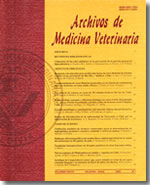Rodents as Leptospira reservoirs at swine farms of the central coffee growers area of Colombia
Main Article Content
Abstract
The positivity to leptospirosis in wild rodents, captured at swine farms from the central coffee growers area of Colombia, by mean of Sherman traps was investigated. Seventy five rats and mice were trapped at 12 out of 16 farms, which indicates that rodents's infestation at the area is high. Once the rodents were classified, the specie R. rattus was found more frequently than R. norvegicus and musculus. A high proportion of the rodents was found Leptospira positive by dark field examination, as well as by cultivation, being this last technique more efficient for the diagnosis. In addition, the point prevalence found for leptospirosis in urine, was higher than the one found by the MAT. Concerning the results of Leptospira in vísceras, it was found that the probability of a positive diagnosis by dark field examination was: lung 0.307; liver 0.221; and kidney 0.211; while the probability of cultivation positive was: kidney 0.300; liver 0.260; and lung 0.227. From this study it was concluded, that the high rodent infestation at the area under study, is a risk factor for leptospira infection for domestic animals and human beings, and that the hog producers should make a great effort to control this pest, which causes a severe economical and health impact.

